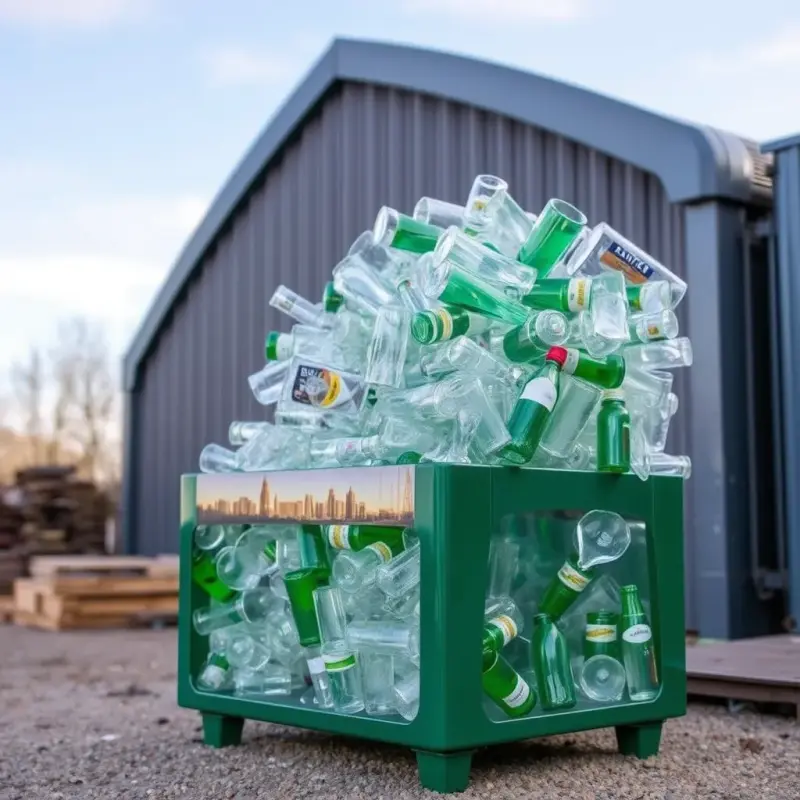Eco-Technologies for Glass Container Recycling: How Systems Help Reduce Waste
The world is becoming increasingly aware of the environmental impact of waste. Glass, while fully recyclable, still ends up in landfills far too often. To address this challenge, innovative eco-technologies have emerged, streamlining the recycling process and helping reduce waste more efficiently than ever before. This article will explore how these technologies work and the benefits they offer for a sustainable future.

The Challenge of Glass Waste
Glass is made from natural materials, primarily silica sand, which is abundant but resource-intensive to extract and process. While glass containers can be recycled endlessly without degrading in quality, the recycling rate worldwide still needs improvement. Improper waste disposal, contamination, and inefficiencies in recycling systems all contribute to glass waste that could otherwise be reused.
How Eco-Technologies Are Transforming Glass Recycling
Modern recycling facilities have adopted a range of technologies to improve the efficiency and effectiveness of recycling glass containers. Here’s a look at some of the most significant advancements:
1. Automated Sorting Systems
One of the biggest challenges in glass recycling is sorting. Traditional methods relied heavily on manual labor, which was not only slow but also prone to errors. Automated sorting systems, equipped with sensors and machine learning algorithms, now efficiently separate glass from other materials. Technologies such as optical scanners and infrared spectroscopy can detect different colors and types of glass, ensuring that they are sorted correctly and ready for further processing.
Benefits: Automated sorting reduces contamination rates and ensures that more glass is recycled to the highest quality standards.
2. Crushing and Pulverizing Machines
Once sorted, glass containers need to be processed into smaller, manageable pieces called cullet. Advanced crushing machines have been designed to break down glass efficiently while minimizing energy consumption and reducing dust emissions. Pulverizing equipment further processes cullet into fine particles, making it easier to melt and reuse in manufacturing.
Benefits: These machines help lower energy use during the melting process and increase the overall efficiency of glass recycling.
3. Energy-Efficient Furnaces
Melting cullet to produce new glass containers requires significant energy. However, eco-technologies have led to the development of energy-efficient furnaces that use less fuel and release fewer greenhouse gases. Innovations include using heat recovery systems to capture and reuse waste heat, as well as optimizing the furnace design to improve melting performance.
Benefits: Energy-efficient furnaces reduce the carbon footprint of glass production and make the recycling process more sustainable.
Smart Waste Collection and Monitoring
Eco-friendly technologies are not limited to the recycling facility itself. Cities and municipalities are investing in smart waste collection systems to make glass recycling more efficient. These systems use sensors and data analytics to monitor waste bins and optimize collection routes, reducing fuel consumption and ensuring that recycling bins are emptied before they overflow.
Benefits: Smart collection systems make recycling more accessible to the public and reduce the overall environmental impact of waste transportation.
Closed-Loop Recycling and Circular Economy
The ultimate goal of eco-technologies in glass recycling is to promote a circular economy, where materials are reused and recycled continuously. Closed-loop recycling systems ensure that used glass containers are collected, processed, and turned back into new containers, creating a sustainable lifecycle for glass products.
Benefits: This approach minimizes the need for raw materials and reduces waste, making the entire process more environmentally friendly.
Challenges and Future Developments
Despite these advancements, there are still challenges to overcome. Contamination from non-recyclable materials and public awareness about proper recycling practices remain hurdles. However, ongoing research and development promise even more efficient and cost-effective solutions in the future.
Innovations in Glass Recycling Materials
Beyond the recycling processes themselves, new materials are being developed to enhance recycling outcomes. For example, special coatings for glass containers are being researched to make them easier to clean and recycle. These coatings could help reduce contamination and improve the efficiency of recycling plants. Additionally, advancements in biodegradable labels and adhesives are minimizing the risk of residue interfering with the recycling process, further optimizing the reuse potential of glass materials.
Eco-technologies for glass recycling are revolutionizing how we handle waste. Automated sorting, energy-efficient furnaces, and smart waste management systems are making it easier and more efficient to recycle glass, reducing landfill waste and conserving natural resources. As these technologies continue to evolve, the potential for a cleaner, more sustainable future becomes increasingly attainable.
Artykuły
Subskrybuj nasze powiadomienia i bądź na bieżąco z najbardziej fascynującymi artykułami, które trafią bezpośrednio na Twój e-mail!